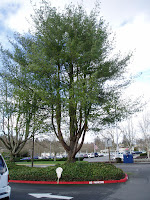 |
| Site location. Click to enlarge. |
Considering that February is the heart of western Washington's rainy season, I have been pleasantly surprised at
how much spidering I've been able to do this month. And since this past week was essentially rain-free, Rod Crawford and I were able to squeeze in one additional field trip before the month draws to a close.
 |
This white pine was conveniently located
in the middle of the trail! |
The day's destination was the northeastern corner of Square Lake, which is located a few miles south of Port Orchard on the Kitsap Peninsula. Note the ridges trending NNE-SSW on the site location map above. They're
relics of the Fraser glaciation. A very interesting topography!
When Rod
sampled a nearby gridspace last year, he noted that western white pines (
Pinus monticola) were present there. Always a good enticement for me, even better that it turned out to be true for this site as well! I was delighted to spot numerous pines next to the trail during the short hike to the lake, not to mention one growing smack dab in middle of the trail itself. And fallen cones were plentiful.
 |
| Mossy pine cone |
Despite no rain reported in the area several days prior to our visit, the cones were heavy with absorbed moisture and full of lots of organic debris. As if to emphasize the moist fertility of the area, many cones even had moss growing on them.
I tapped my usual sample of 50 cones and collected 10 spiders and 57 (!) pseudoscorpions. All but one of the spiders were from the family Linyphiidae (the other was an agelenid), while all but one of the pseudoscorpions were from the family Neobisiidae (the other was from Chthoniidae). I later tapped an additional 10 cones which produced 2 more linyphiids and even more pseudoscorpions, the latter which I didn't have the heart to collect.
 |
| Female Wubana pacifica |
 |
A bit blurry, but this photo shows
Wubana's white "butt spot" (not
the technical term :) |
Three spider species were identifiable in my cones sample:
Frederickus coylei,
Wubana pacifica and
Lepthyphantes zelatus. Although all three species are common in western Washington leaf litter, we didn't collect the first two in any other microhabitat at this site. Once again, cone tapping saves the day! Or at least, helps fill out the site species list.
 |
Just a few of the dozens of pseudo-
scorpions I tapped from pine cones |
Rod noted how rotund many of the pseudoscorpions were and wondered whether they were perhaps full of eggs. Whatever the explanation, they sure seemed to be flourishing in these pine cones. At an average of 1.14 pseudoscorpions per cone, this was by far the highest density I've tapped from fallen cones. The next highest density was 0.56 that I
tapped in October 2011 from ponderosa pine cones in Brooks Memorial State Park (Klickitat County).
Since western white pines are not the dominant forest tree species anywhere in Washington state, I've had to hone my pine-spotting skills in order to find them. When I have a good line of sight into the forest canopy, I usually find them by spotting the tree's feathery foliage and large, pendant cones. But when I'm inside a dense forest where the canopy is just a distant, indistinguishable mass of green, I simply search for fallen cones along the trail and look for the western white pine's unique bark pattern on nearby tree trunks.
 |
Looking up the unusual pine
with the alder-appearing trunk |
Mature western white pines have fairly smooth grey bark broken into flat rectangular scales. It's often described as "checkered". The pattern is always visible because pine bark is never obscured by epiphytes...or so I thought until we visited Square Lake! Almost immediately upon hitting the trail I spotted the foliage and pendant cones of a nearby mature white pine. But as my gaze slid down the trunk of the tree, I was surprised to see that it was entirely covered in epiphytes. Had I not seen its crown, I would have been certain I was looking at an alder! Alder (
Alnus) bark is typically "painted" with accumulations of mosses, liverworts, lichens, and algae. As the saying goes, to every rule there is an exception.
 |
| Tree trunk comparison. A. typical white pine, B. unusual alder-appearing white pine, C. typical alder |
Read Rod's trip description
here.






























